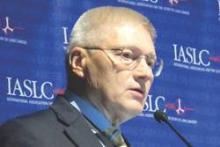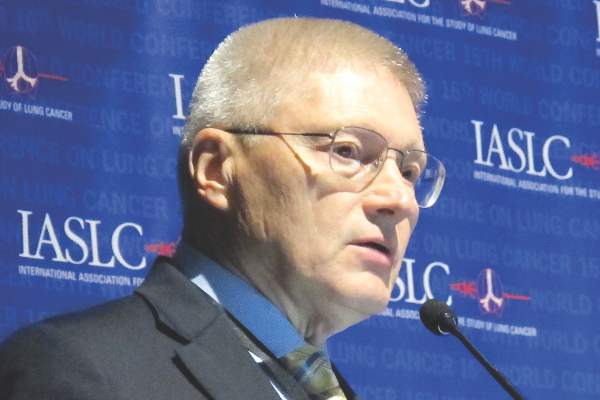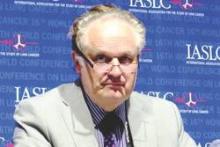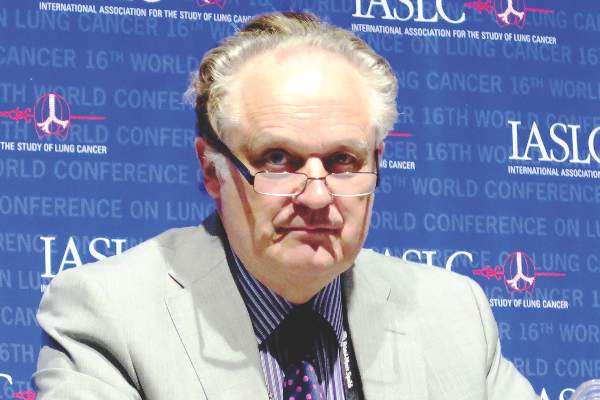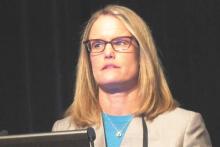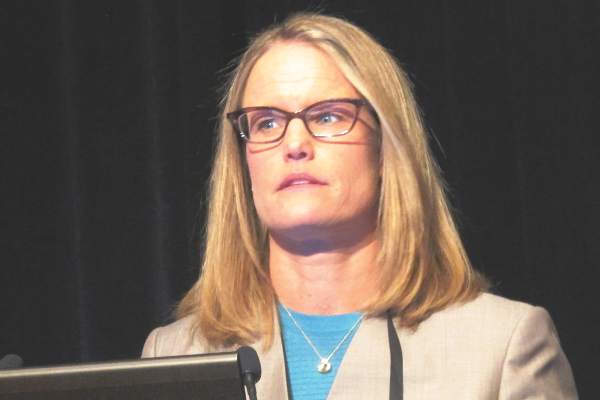User login
Hunger hormone mimic anamorelin treats cachexia in NSCLC
DENVER – Anamorelin, an investigational compound that mimics the action of the so-called “hunger hormone” ghrelin, was effective at helping patients with cachexia gain weight, but fell short when it came to improving hand-grip strength, a surrogate for muscle mass, results of two clinical trials showed.
Among patients with advanced non–small cell lung cancer (NSCLC) and cachexia enrolled in two randomized clinical trials, those who took anamorelin daily over 12 weeks gained about 1 kg of lean body mass, compared with patients on placebo, who experienced further losses of lean body mass.
“Weight loss and loss of appetite are dominant symptoms in lung cancer patients, especially advanced lung cancer patients. About 70% experience this problem, and it’s something we hear in the clinic every day: Patients are frustrated and the family’s frustrated trying to get the patient to eat, but he or she can’t do it,” said investigator Dr. Philip Bonomi from Rush University Medical Center in Chicago.
He discussed results of the phase III ROMANA 1 and ROMANA 2 trials at a media briefing here at a world conference on lung cancer sponsored by the International Association for the Study of Lung Cancer.
Cachexia, defined as a loss of 5% or more of body weight over 6 months or a body mass index below 20 kg/m2, is associated with poor clinical outcomes, including worse functional status, decreased quality of life, and shorter survival.
Anamorelin is an orally active selective ghrelin receptor agonist designed to mimic the hunger-inducing and anabolic effects of the natural hormone.
In the independent ROMANA 1 and ROMANA 2 trials, a total of 979 patients with unresectable stage III or IV NSCLC and cachexia were randomly assigned on a 2:1 basis to receive anamorelin 100 mg orally per day or placebo for 12 weeks.
For the coprimary endpoint of change in lean body mass patients assigned to anamorelin in ROMANA 1 (323 patients) had a median gain in lean body mass of 1.1 kg over 12 weeks, compared with a loss of 0.44 kg among 161 patients who received placebo (P less than .001)
In ROMANA 2, the 330 patients assigned to anamorelin gained a median of 0.75 kg, while the 165 assigned to placebo lost a median of 0.96 kg (P less than .001).
But for the other coprimary endpoint of improvement in hand-grip strength, patients in each arm of each trial lost strength over the 12 weeks, and there were no significant between-group differences, Dr. Bonomi said.
For the secondary endpoint of change in anorexia/cachexia domain of the Functional Assessment of Anorexia/Cachexia Therapy (FAACT) questionnaire, patients who received anamorelin in each trial had significantly greater mean change from baseline in scores (4.12 vs. 1.92 for placebo in ROMANA 1; P = .0004: and 3.48 vs. 1.34 in ROMANA 2; P = .0016).
A prespecified exploratory-responder analysis also showed approximately twice as many patients treated with anamorelin maintained or gained lean body mass over the course of the study, compared with controls.
Regarding the failure of the drug to meet one of its primary endpoints, improvement of hand-grip strength as measure of gain in muscle mass, Dr. Bonomi said “Was it the right thing to measure? Many people think probably not, but nevertheless, there was no difference in hand-grip strength.”
He said that future studies should focus on whether therapies for cachexia can help improve patient’s physical functioning and activities of daily living.
DENVER – Anamorelin, an investigational compound that mimics the action of the so-called “hunger hormone” ghrelin, was effective at helping patients with cachexia gain weight, but fell short when it came to improving hand-grip strength, a surrogate for muscle mass, results of two clinical trials showed.
Among patients with advanced non–small cell lung cancer (NSCLC) and cachexia enrolled in two randomized clinical trials, those who took anamorelin daily over 12 weeks gained about 1 kg of lean body mass, compared with patients on placebo, who experienced further losses of lean body mass.
“Weight loss and loss of appetite are dominant symptoms in lung cancer patients, especially advanced lung cancer patients. About 70% experience this problem, and it’s something we hear in the clinic every day: Patients are frustrated and the family’s frustrated trying to get the patient to eat, but he or she can’t do it,” said investigator Dr. Philip Bonomi from Rush University Medical Center in Chicago.
He discussed results of the phase III ROMANA 1 and ROMANA 2 trials at a media briefing here at a world conference on lung cancer sponsored by the International Association for the Study of Lung Cancer.
Cachexia, defined as a loss of 5% or more of body weight over 6 months or a body mass index below 20 kg/m2, is associated with poor clinical outcomes, including worse functional status, decreased quality of life, and shorter survival.
Anamorelin is an orally active selective ghrelin receptor agonist designed to mimic the hunger-inducing and anabolic effects of the natural hormone.
In the independent ROMANA 1 and ROMANA 2 trials, a total of 979 patients with unresectable stage III or IV NSCLC and cachexia were randomly assigned on a 2:1 basis to receive anamorelin 100 mg orally per day or placebo for 12 weeks.
For the coprimary endpoint of change in lean body mass patients assigned to anamorelin in ROMANA 1 (323 patients) had a median gain in lean body mass of 1.1 kg over 12 weeks, compared with a loss of 0.44 kg among 161 patients who received placebo (P less than .001)
In ROMANA 2, the 330 patients assigned to anamorelin gained a median of 0.75 kg, while the 165 assigned to placebo lost a median of 0.96 kg (P less than .001).
But for the other coprimary endpoint of improvement in hand-grip strength, patients in each arm of each trial lost strength over the 12 weeks, and there were no significant between-group differences, Dr. Bonomi said.
For the secondary endpoint of change in anorexia/cachexia domain of the Functional Assessment of Anorexia/Cachexia Therapy (FAACT) questionnaire, patients who received anamorelin in each trial had significantly greater mean change from baseline in scores (4.12 vs. 1.92 for placebo in ROMANA 1; P = .0004: and 3.48 vs. 1.34 in ROMANA 2; P = .0016).
A prespecified exploratory-responder analysis also showed approximately twice as many patients treated with anamorelin maintained or gained lean body mass over the course of the study, compared with controls.
Regarding the failure of the drug to meet one of its primary endpoints, improvement of hand-grip strength as measure of gain in muscle mass, Dr. Bonomi said “Was it the right thing to measure? Many people think probably not, but nevertheless, there was no difference in hand-grip strength.”
He said that future studies should focus on whether therapies for cachexia can help improve patient’s physical functioning and activities of daily living.
DENVER – Anamorelin, an investigational compound that mimics the action of the so-called “hunger hormone” ghrelin, was effective at helping patients with cachexia gain weight, but fell short when it came to improving hand-grip strength, a surrogate for muscle mass, results of two clinical trials showed.
Among patients with advanced non–small cell lung cancer (NSCLC) and cachexia enrolled in two randomized clinical trials, those who took anamorelin daily over 12 weeks gained about 1 kg of lean body mass, compared with patients on placebo, who experienced further losses of lean body mass.
“Weight loss and loss of appetite are dominant symptoms in lung cancer patients, especially advanced lung cancer patients. About 70% experience this problem, and it’s something we hear in the clinic every day: Patients are frustrated and the family’s frustrated trying to get the patient to eat, but he or she can’t do it,” said investigator Dr. Philip Bonomi from Rush University Medical Center in Chicago.
He discussed results of the phase III ROMANA 1 and ROMANA 2 trials at a media briefing here at a world conference on lung cancer sponsored by the International Association for the Study of Lung Cancer.
Cachexia, defined as a loss of 5% or more of body weight over 6 months or a body mass index below 20 kg/m2, is associated with poor clinical outcomes, including worse functional status, decreased quality of life, and shorter survival.
Anamorelin is an orally active selective ghrelin receptor agonist designed to mimic the hunger-inducing and anabolic effects of the natural hormone.
In the independent ROMANA 1 and ROMANA 2 trials, a total of 979 patients with unresectable stage III or IV NSCLC and cachexia were randomly assigned on a 2:1 basis to receive anamorelin 100 mg orally per day or placebo for 12 weeks.
For the coprimary endpoint of change in lean body mass patients assigned to anamorelin in ROMANA 1 (323 patients) had a median gain in lean body mass of 1.1 kg over 12 weeks, compared with a loss of 0.44 kg among 161 patients who received placebo (P less than .001)
In ROMANA 2, the 330 patients assigned to anamorelin gained a median of 0.75 kg, while the 165 assigned to placebo lost a median of 0.96 kg (P less than .001).
But for the other coprimary endpoint of improvement in hand-grip strength, patients in each arm of each trial lost strength over the 12 weeks, and there were no significant between-group differences, Dr. Bonomi said.
For the secondary endpoint of change in anorexia/cachexia domain of the Functional Assessment of Anorexia/Cachexia Therapy (FAACT) questionnaire, patients who received anamorelin in each trial had significantly greater mean change from baseline in scores (4.12 vs. 1.92 for placebo in ROMANA 1; P = .0004: and 3.48 vs. 1.34 in ROMANA 2; P = .0016).
A prespecified exploratory-responder analysis also showed approximately twice as many patients treated with anamorelin maintained or gained lean body mass over the course of the study, compared with controls.
Regarding the failure of the drug to meet one of its primary endpoints, improvement of hand-grip strength as measure of gain in muscle mass, Dr. Bonomi said “Was it the right thing to measure? Many people think probably not, but nevertheless, there was no difference in hand-grip strength.”
He said that future studies should focus on whether therapies for cachexia can help improve patient’s physical functioning and activities of daily living.
AT THE WORLD CONGRESS ON LUNG CANCER
Key clinical point: The ghrelin receptor agonist anamorelin helped patients with cancer cachexia gain lean body mass.
Major finding: Patients cachexia on anamorelin in two studies gained lean body mass over 12 weeks, while patients on placebo lost mass.
Data source: Two independent randomized phase III trials enrolling a total of 979 patients with advanced non–small cell lung cancer and cachexia.
Disclosures: The studies were sponsored by Helsinn Therapeutics. Dr. Bonomi serves on the advisory board to the company and has received honoraria from it.
Workshop tackles finer points of lung cancer screening
DENVER – In its third CT Screening Workshop, the Strategic Screening Advisory Committee of the International Association for the Study of Lung Cancer discussed the finer points of using this technology to screen for lung cancer, including issues such as metrics, quality control, and cost-effectiveness.
“Lung cancer is the major problem of all cancers,” committee chair Dr. John K. Field maintained in press conference at the annual World Conference on Lung Cancer, which was held in conjunction with the workshop. This cancer still causes more deaths than all of those from breast, colon, and prostate cancer combined.
“However, the good news is that the future does lie in early detection,” he said. The National Lung Screening Trial established that low-dose CT screening reduces the risk of lung cancer death by 20% compared with plain chest radiographic screening (N Engl J Med. 2011;365:395-409).
“That was the first time anybody had actually demonstrated such a mortality advantage with anything in lung cancer, so it led to an enormous stage shift in our thinking,” noted Dr. Field, who is also Personal Clinical Chair in Molecular Oncology at the University of Liverpool, England.
In the workshop, committee members reviewed new guidelines on managing screen-detected nodules from the ongoing NELSON (Dutch Belgian Randomised Lung Cancer Screening Trial) (Lancet Oncol. 2014;15:1332-41) and from the British Thoracic Society (Thorax. 2015;70:794-8). Main results from NELSON, as well as from the similar U.K. Lung Cancer Screening Trial, are expected shortly.
“We also looked at quality control for future screening programs. It’s extremely important that if we do have screening in place, that we have the necessary quality control behind it,” Dr. Field asserted.
Another topic discussed was whether CT screening is cost-effective. “Cost-effectiveness is going to be a major issue, especially in Europe,” where policy makers are awaiting results from the two trials before implementing screening, he said. “At this moment in time, it looks as though we will be cost-effective.”
The committee also assessed the potential of lung cancer biomarkers. “If we can actually improve the CT screening by using a particular biomarker, that would help us identify individuals easier. But also, once we undertake the CT, we are sometimes left with a gray situation of nodules that may become malignant but are not large enough to actually undertake any surgical intervention. And if we had a biomarker that would tell us if it was an aggressive tumor, that would be an enormous advantage,” Dr. Field elaborated.
Finally, the committee reviewed the status of national plans for implementing lung cancer CT screening around the world. Implementation is a multistep process requiring clinical experts and policy makers to hammer out a variety of issues, he noted (Lancet. 2013;382:732-41).
These issues include how best to identify individuals at high risk, typically accomplished with the LLP (Liverpool Lung Project) risk model in the United Kingdom and the PLCO (Prostate, Lung, Colorectal, and Ovarian) risk model in the United States. Screening age must also be considered. “In the U.K., our recommendation would probably be 60-75, but in the U.S. it would be 55-80, which came from the U.S. Preventive Services Task Force,” Dr. Field noted.
Another issue is whether nodules identified on CT are better measured by their maximal diameter (used in the National Lung Screening Trial) or their volume (used in the ongoing NELSON and U.K. trials). “There are advantages and disadvantages of both. We feel that volume is the way forward,” he said.
The nature of any subsequent work-up, including whether a biopsy is performed and additional tests, is also a consideration, as is the management of small nodules, including whether patients should undergo video-assisted thoracoscopic surgery.
Similarly, clinical experts and policy makers must decide on the optimal screening interval, whether every year or every 2 years, as well as the age at which to stop screening, he noted. And cost-effectiveness will be a critical point.
Workshop attendees from around the world shared current screening practices in their countries. “It’s quite clear that we all have different approaches, but we all have one objective: to identify high-risk individuals early. And we know if we identify them early, successful surgery will actually give them a long life,” Dr. Field said.
“Therefore, we feel that the future is through screening and we need to implement it. At this moment in time, the funding is there within the U.S., we are moving towards implementing it. In Europe, we are still waiting for the NELSON trial, but we are looking at an 18-month or 2-year period where that decision hopefully will be made,” he concluded.
Dr. Field disclosed no relevant conflicts of interest.
DENVER – In its third CT Screening Workshop, the Strategic Screening Advisory Committee of the International Association for the Study of Lung Cancer discussed the finer points of using this technology to screen for lung cancer, including issues such as metrics, quality control, and cost-effectiveness.
“Lung cancer is the major problem of all cancers,” committee chair Dr. John K. Field maintained in press conference at the annual World Conference on Lung Cancer, which was held in conjunction with the workshop. This cancer still causes more deaths than all of those from breast, colon, and prostate cancer combined.
“However, the good news is that the future does lie in early detection,” he said. The National Lung Screening Trial established that low-dose CT screening reduces the risk of lung cancer death by 20% compared with plain chest radiographic screening (N Engl J Med. 2011;365:395-409).
“That was the first time anybody had actually demonstrated such a mortality advantage with anything in lung cancer, so it led to an enormous stage shift in our thinking,” noted Dr. Field, who is also Personal Clinical Chair in Molecular Oncology at the University of Liverpool, England.
In the workshop, committee members reviewed new guidelines on managing screen-detected nodules from the ongoing NELSON (Dutch Belgian Randomised Lung Cancer Screening Trial) (Lancet Oncol. 2014;15:1332-41) and from the British Thoracic Society (Thorax. 2015;70:794-8). Main results from NELSON, as well as from the similar U.K. Lung Cancer Screening Trial, are expected shortly.
“We also looked at quality control for future screening programs. It’s extremely important that if we do have screening in place, that we have the necessary quality control behind it,” Dr. Field asserted.
Another topic discussed was whether CT screening is cost-effective. “Cost-effectiveness is going to be a major issue, especially in Europe,” where policy makers are awaiting results from the two trials before implementing screening, he said. “At this moment in time, it looks as though we will be cost-effective.”
The committee also assessed the potential of lung cancer biomarkers. “If we can actually improve the CT screening by using a particular biomarker, that would help us identify individuals easier. But also, once we undertake the CT, we are sometimes left with a gray situation of nodules that may become malignant but are not large enough to actually undertake any surgical intervention. And if we had a biomarker that would tell us if it was an aggressive tumor, that would be an enormous advantage,” Dr. Field elaborated.
Finally, the committee reviewed the status of national plans for implementing lung cancer CT screening around the world. Implementation is a multistep process requiring clinical experts and policy makers to hammer out a variety of issues, he noted (Lancet. 2013;382:732-41).
These issues include how best to identify individuals at high risk, typically accomplished with the LLP (Liverpool Lung Project) risk model in the United Kingdom and the PLCO (Prostate, Lung, Colorectal, and Ovarian) risk model in the United States. Screening age must also be considered. “In the U.K., our recommendation would probably be 60-75, but in the U.S. it would be 55-80, which came from the U.S. Preventive Services Task Force,” Dr. Field noted.
Another issue is whether nodules identified on CT are better measured by their maximal diameter (used in the National Lung Screening Trial) or their volume (used in the ongoing NELSON and U.K. trials). “There are advantages and disadvantages of both. We feel that volume is the way forward,” he said.
The nature of any subsequent work-up, including whether a biopsy is performed and additional tests, is also a consideration, as is the management of small nodules, including whether patients should undergo video-assisted thoracoscopic surgery.
Similarly, clinical experts and policy makers must decide on the optimal screening interval, whether every year or every 2 years, as well as the age at which to stop screening, he noted. And cost-effectiveness will be a critical point.
Workshop attendees from around the world shared current screening practices in their countries. “It’s quite clear that we all have different approaches, but we all have one objective: to identify high-risk individuals early. And we know if we identify them early, successful surgery will actually give them a long life,” Dr. Field said.
“Therefore, we feel that the future is through screening and we need to implement it. At this moment in time, the funding is there within the U.S., we are moving towards implementing it. In Europe, we are still waiting for the NELSON trial, but we are looking at an 18-month or 2-year period where that decision hopefully will be made,” he concluded.
Dr. Field disclosed no relevant conflicts of interest.
DENVER – In its third CT Screening Workshop, the Strategic Screening Advisory Committee of the International Association for the Study of Lung Cancer discussed the finer points of using this technology to screen for lung cancer, including issues such as metrics, quality control, and cost-effectiveness.
“Lung cancer is the major problem of all cancers,” committee chair Dr. John K. Field maintained in press conference at the annual World Conference on Lung Cancer, which was held in conjunction with the workshop. This cancer still causes more deaths than all of those from breast, colon, and prostate cancer combined.
“However, the good news is that the future does lie in early detection,” he said. The National Lung Screening Trial established that low-dose CT screening reduces the risk of lung cancer death by 20% compared with plain chest radiographic screening (N Engl J Med. 2011;365:395-409).
“That was the first time anybody had actually demonstrated such a mortality advantage with anything in lung cancer, so it led to an enormous stage shift in our thinking,” noted Dr. Field, who is also Personal Clinical Chair in Molecular Oncology at the University of Liverpool, England.
In the workshop, committee members reviewed new guidelines on managing screen-detected nodules from the ongoing NELSON (Dutch Belgian Randomised Lung Cancer Screening Trial) (Lancet Oncol. 2014;15:1332-41) and from the British Thoracic Society (Thorax. 2015;70:794-8). Main results from NELSON, as well as from the similar U.K. Lung Cancer Screening Trial, are expected shortly.
“We also looked at quality control for future screening programs. It’s extremely important that if we do have screening in place, that we have the necessary quality control behind it,” Dr. Field asserted.
Another topic discussed was whether CT screening is cost-effective. “Cost-effectiveness is going to be a major issue, especially in Europe,” where policy makers are awaiting results from the two trials before implementing screening, he said. “At this moment in time, it looks as though we will be cost-effective.”
The committee also assessed the potential of lung cancer biomarkers. “If we can actually improve the CT screening by using a particular biomarker, that would help us identify individuals easier. But also, once we undertake the CT, we are sometimes left with a gray situation of nodules that may become malignant but are not large enough to actually undertake any surgical intervention. And if we had a biomarker that would tell us if it was an aggressive tumor, that would be an enormous advantage,” Dr. Field elaborated.
Finally, the committee reviewed the status of national plans for implementing lung cancer CT screening around the world. Implementation is a multistep process requiring clinical experts and policy makers to hammer out a variety of issues, he noted (Lancet. 2013;382:732-41).
These issues include how best to identify individuals at high risk, typically accomplished with the LLP (Liverpool Lung Project) risk model in the United Kingdom and the PLCO (Prostate, Lung, Colorectal, and Ovarian) risk model in the United States. Screening age must also be considered. “In the U.K., our recommendation would probably be 60-75, but in the U.S. it would be 55-80, which came from the U.S. Preventive Services Task Force,” Dr. Field noted.
Another issue is whether nodules identified on CT are better measured by their maximal diameter (used in the National Lung Screening Trial) or their volume (used in the ongoing NELSON and U.K. trials). “There are advantages and disadvantages of both. We feel that volume is the way forward,” he said.
The nature of any subsequent work-up, including whether a biopsy is performed and additional tests, is also a consideration, as is the management of small nodules, including whether patients should undergo video-assisted thoracoscopic surgery.
Similarly, clinical experts and policy makers must decide on the optimal screening interval, whether every year or every 2 years, as well as the age at which to stop screening, he noted. And cost-effectiveness will be a critical point.
Workshop attendees from around the world shared current screening practices in their countries. “It’s quite clear that we all have different approaches, but we all have one objective: to identify high-risk individuals early. And we know if we identify them early, successful surgery will actually give them a long life,” Dr. Field said.
“Therefore, we feel that the future is through screening and we need to implement it. At this moment in time, the funding is there within the U.S., we are moving towards implementing it. In Europe, we are still waiting for the NELSON trial, but we are looking at an 18-month or 2-year period where that decision hopefully will be made,” he concluded.
Dr. Field disclosed no relevant conflicts of interest.
EXPERT ANALYSIS FROM THE IASLC WORLD CONFERENCE
Nivolumab continues to offer better survival for squamous NSCLC patients
DENVER – The checkpoint inhibitor nivolumab continues to outflank docetaxel in the treatment of patients with advanced squamous cell non–small cell lung cancer, updated clinical trial results showed.
At 18 months’ follow-up, the overall survival (OS) rate of patients with advanced NSCLC treated with nivolumab (Opdivo) was more than double that of patients treated with docetaxel (Taxotere). Nivolumab was also associated with significantly better progression-free survival and median overall survival, reported Dr. Karen Reckamp of the City of Hope Comprehensive Cancer Center in Duarte, Calif.
She reported updated results of the Checkmate 017 trial at a world conference on lung cancer sponsored by the International Association for the Study of Lung Cancer..
“Nivolumab benefit was independent of PD-L1 expression and was [seen] across all clinical subgroups. The safety profile of nivolumab continues to be favorable versus docetaxel and is consistent with previous studies,” she said.
Nivolumab is a fully human programmed death-1 (PD-1) immune checkpoint inhibitor. It has been shown in clinical trials to offer a survival benefit with manageable toxicity, compared with docetaxel in patients with metastatic squamous and nonsquamous NSCLC who had disease progression after treatment with platinum-based doublet chemotherapy.
In Checkmate 017, patients with stage III or IV squamous NSCLC who had received firstline chemotherapy were randomly assigned to receive either nivolumab 3 mg/kg IV every 2 weeks (135 patients) or docetaxel 75 mg/m2 every 3 weeks (137 patients) until disease progression or unacceptable toxicities occurred.
At the 2015 annual meeting of the American Society of Clinical Oncology, Checkmate 017 investigators reported that nivolumab reduced the risk of death by 41%, compared with docetaxel, in previously treated advanced squamous NSCLC (hazard ratio [HR], 0.59; P = .00025) after 12 months of follow-up. The 1-year OS for patients treated with nivolumab was 42%, compared with 24% for patients treated with docetaxel.
In the current analysis after a minimum follow-up of 18 months, the overall survival rate for nivolumab-treated patients was 28%, compared with 13% for docetaxel-treated patients.
The median overall survival was 9.2 months and 6.0 months, respectively. The HR favoring nivolumab was 0.62 (P = .0004).
As noted before, the treatment effect on OS favored the checkpoint inhibitor over the taxane in all predefined subgroups, including prior chemotherapy type, region, age, Eastern Cooperative Oncology Group (ECOG) performance status, time from completion of last treatment regimen to randomizations, brain metastases, and smoking status.
The progression-free survival (PFS) rate at 18 months’ follow-up was also significantly better with nivolumab, at 17%, compared with 2.7%. The median PFS was 3.5 months and 2.8 months, prospectively, and the HR was 0.63 (P = .0008).
Treatment-related adverse events of any grade were seen in 59% of patients on nivolumab and 87% of those on docetaxel. Grade 3 or greater adverse events occurred in 8% of patients on the checkpoint inhibitor, vs. 58% of those treated with the taxane.
There were no deaths among nivolumab-treated patients, but two docetaxel-treated patients died.
Although the results are encouraging and consistent with those seen in other clinical trials of nivolumab in second-line therapy for squamous NSCLC, performance status is a limiting factor, commented Dr. Solange Peters of the Lausane (Switzerland) University Hospital, the invited discussant.
She noted that all patients in Checkmate 017 had an Eastern Cooperative Oncology Group status of 0 or 1.
She also noted that OS with nivolumab (9.2 months) is only incrementally better in the unselected patient population than with docetaxel (6.3 months), or with targeted therapies such as afatinib (7.9 months) or erlotinib (6.8 months).
“Unselected squamous cell carcinoma of the lung remains a disease characterized by a high unmet medical need,” she said.
The study was sponsored by Bristol-Myers Squibb. Dr. Reckamp and Dr. Peters disclosed receiving consulting fees from the company.
DENVER – The checkpoint inhibitor nivolumab continues to outflank docetaxel in the treatment of patients with advanced squamous cell non–small cell lung cancer, updated clinical trial results showed.
At 18 months’ follow-up, the overall survival (OS) rate of patients with advanced NSCLC treated with nivolumab (Opdivo) was more than double that of patients treated with docetaxel (Taxotere). Nivolumab was also associated with significantly better progression-free survival and median overall survival, reported Dr. Karen Reckamp of the City of Hope Comprehensive Cancer Center in Duarte, Calif.
She reported updated results of the Checkmate 017 trial at a world conference on lung cancer sponsored by the International Association for the Study of Lung Cancer..
“Nivolumab benefit was independent of PD-L1 expression and was [seen] across all clinical subgroups. The safety profile of nivolumab continues to be favorable versus docetaxel and is consistent with previous studies,” she said.
Nivolumab is a fully human programmed death-1 (PD-1) immune checkpoint inhibitor. It has been shown in clinical trials to offer a survival benefit with manageable toxicity, compared with docetaxel in patients with metastatic squamous and nonsquamous NSCLC who had disease progression after treatment with platinum-based doublet chemotherapy.
In Checkmate 017, patients with stage III or IV squamous NSCLC who had received firstline chemotherapy were randomly assigned to receive either nivolumab 3 mg/kg IV every 2 weeks (135 patients) or docetaxel 75 mg/m2 every 3 weeks (137 patients) until disease progression or unacceptable toxicities occurred.
At the 2015 annual meeting of the American Society of Clinical Oncology, Checkmate 017 investigators reported that nivolumab reduced the risk of death by 41%, compared with docetaxel, in previously treated advanced squamous NSCLC (hazard ratio [HR], 0.59; P = .00025) after 12 months of follow-up. The 1-year OS for patients treated with nivolumab was 42%, compared with 24% for patients treated with docetaxel.
In the current analysis after a minimum follow-up of 18 months, the overall survival rate for nivolumab-treated patients was 28%, compared with 13% for docetaxel-treated patients.
The median overall survival was 9.2 months and 6.0 months, respectively. The HR favoring nivolumab was 0.62 (P = .0004).
As noted before, the treatment effect on OS favored the checkpoint inhibitor over the taxane in all predefined subgroups, including prior chemotherapy type, region, age, Eastern Cooperative Oncology Group (ECOG) performance status, time from completion of last treatment regimen to randomizations, brain metastases, and smoking status.
The progression-free survival (PFS) rate at 18 months’ follow-up was also significantly better with nivolumab, at 17%, compared with 2.7%. The median PFS was 3.5 months and 2.8 months, prospectively, and the HR was 0.63 (P = .0008).
Treatment-related adverse events of any grade were seen in 59% of patients on nivolumab and 87% of those on docetaxel. Grade 3 or greater adverse events occurred in 8% of patients on the checkpoint inhibitor, vs. 58% of those treated with the taxane.
There were no deaths among nivolumab-treated patients, but two docetaxel-treated patients died.
Although the results are encouraging and consistent with those seen in other clinical trials of nivolumab in second-line therapy for squamous NSCLC, performance status is a limiting factor, commented Dr. Solange Peters of the Lausane (Switzerland) University Hospital, the invited discussant.
She noted that all patients in Checkmate 017 had an Eastern Cooperative Oncology Group status of 0 or 1.
She also noted that OS with nivolumab (9.2 months) is only incrementally better in the unselected patient population than with docetaxel (6.3 months), or with targeted therapies such as afatinib (7.9 months) or erlotinib (6.8 months).
“Unselected squamous cell carcinoma of the lung remains a disease characterized by a high unmet medical need,” she said.
The study was sponsored by Bristol-Myers Squibb. Dr. Reckamp and Dr. Peters disclosed receiving consulting fees from the company.
DENVER – The checkpoint inhibitor nivolumab continues to outflank docetaxel in the treatment of patients with advanced squamous cell non–small cell lung cancer, updated clinical trial results showed.
At 18 months’ follow-up, the overall survival (OS) rate of patients with advanced NSCLC treated with nivolumab (Opdivo) was more than double that of patients treated with docetaxel (Taxotere). Nivolumab was also associated with significantly better progression-free survival and median overall survival, reported Dr. Karen Reckamp of the City of Hope Comprehensive Cancer Center in Duarte, Calif.
She reported updated results of the Checkmate 017 trial at a world conference on lung cancer sponsored by the International Association for the Study of Lung Cancer..
“Nivolumab benefit was independent of PD-L1 expression and was [seen] across all clinical subgroups. The safety profile of nivolumab continues to be favorable versus docetaxel and is consistent with previous studies,” she said.
Nivolumab is a fully human programmed death-1 (PD-1) immune checkpoint inhibitor. It has been shown in clinical trials to offer a survival benefit with manageable toxicity, compared with docetaxel in patients with metastatic squamous and nonsquamous NSCLC who had disease progression after treatment with platinum-based doublet chemotherapy.
In Checkmate 017, patients with stage III or IV squamous NSCLC who had received firstline chemotherapy were randomly assigned to receive either nivolumab 3 mg/kg IV every 2 weeks (135 patients) or docetaxel 75 mg/m2 every 3 weeks (137 patients) until disease progression or unacceptable toxicities occurred.
At the 2015 annual meeting of the American Society of Clinical Oncology, Checkmate 017 investigators reported that nivolumab reduced the risk of death by 41%, compared with docetaxel, in previously treated advanced squamous NSCLC (hazard ratio [HR], 0.59; P = .00025) after 12 months of follow-up. The 1-year OS for patients treated with nivolumab was 42%, compared with 24% for patients treated with docetaxel.
In the current analysis after a minimum follow-up of 18 months, the overall survival rate for nivolumab-treated patients was 28%, compared with 13% for docetaxel-treated patients.
The median overall survival was 9.2 months and 6.0 months, respectively. The HR favoring nivolumab was 0.62 (P = .0004).
As noted before, the treatment effect on OS favored the checkpoint inhibitor over the taxane in all predefined subgroups, including prior chemotherapy type, region, age, Eastern Cooperative Oncology Group (ECOG) performance status, time from completion of last treatment regimen to randomizations, brain metastases, and smoking status.
The progression-free survival (PFS) rate at 18 months’ follow-up was also significantly better with nivolumab, at 17%, compared with 2.7%. The median PFS was 3.5 months and 2.8 months, prospectively, and the HR was 0.63 (P = .0008).
Treatment-related adverse events of any grade were seen in 59% of patients on nivolumab and 87% of those on docetaxel. Grade 3 or greater adverse events occurred in 8% of patients on the checkpoint inhibitor, vs. 58% of those treated with the taxane.
There were no deaths among nivolumab-treated patients, but two docetaxel-treated patients died.
Although the results are encouraging and consistent with those seen in other clinical trials of nivolumab in second-line therapy for squamous NSCLC, performance status is a limiting factor, commented Dr. Solange Peters of the Lausane (Switzerland) University Hospital, the invited discussant.
She noted that all patients in Checkmate 017 had an Eastern Cooperative Oncology Group status of 0 or 1.
She also noted that OS with nivolumab (9.2 months) is only incrementally better in the unselected patient population than with docetaxel (6.3 months), or with targeted therapies such as afatinib (7.9 months) or erlotinib (6.8 months).
“Unselected squamous cell carcinoma of the lung remains a disease characterized by a high unmet medical need,” she said.
The study was sponsored by Bristol-Myers Squibb. Dr. Reckamp and Dr. Peters disclosed receiving consulting fees from the company.
AT THE IASLC WORLD CONFERENCE
Key clinical point: The checkpoint inhibitor nivolumab provides a survival advantage over docetaxel in advanced squamous non–small cell lung cancer.
Major finding: The median overall survival was 9.2 months for nivolumab-treated patients and 6.0 months for docetaxel-treated patients.
Data source: A randomized clinical trial in 272 patients with stage III or IV squamous NSCLC.
Disclosures: The study was sponsored by Bristol-Myers Squibb. Dr. Reckamp and Dr. Peters disclosed receiving consulting fees from the company.
